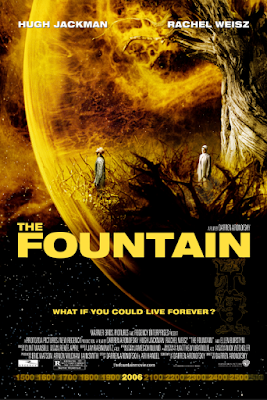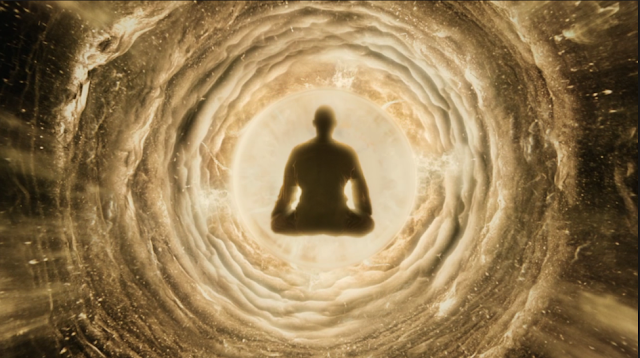‘The Fountain’ Has Nothing to Do with Time
NOVEMBER 22, 2016
I adore Darren Aronofsky’s The Fountain. It’s one of my all-time favorite films. I get something new from it every time I watch it, and I watch it at least once a year. I’ve listened to Clint Mansell’s score countless times. The film features Aronofsky at his most earnest and operatic, and while the film flopped when it was released ten years ago, it has gone on to gain a cult following.
However, there also seems to be a common misconception with how the film approaches its narrative. It’s a problem that likely began with the film’s trailer:
As you can see from the trailer, it lays out the three narratives as existing in three time periods: 1500, 2000, and 2500. So if you saw the trailer, you would assume that’s how Aronofsky structured his film. While it’s clear that what’s happening in “1500” is Isabel Creo’s (Rachel Weisz) story “The Fountain” about a conquistador who travels to find The Fountain of Youth in order to empower his Queen, and that in the year 2000, Tommy Creo (Hugh Jackman) is a scientist searching to find a cure for his wife’s illness, we’re left to assume that in the year 2500, “Tom Creo” (as he’s referred to in the credits) is now traveling in a spaceship of some kind with the tree that has allowed him to extend his life.
 But that’s not actually what’s happening, and the “future” Tom Creo isn’t in the future at all. There’s nothing in the film itself to suggest that the year is 2500 or a future of any kind. In fact, all of the evidence points to something far richer but more complicated: The Tom Creo we see in the bubble is Tommy Creo’s mind.
But that’s not actually what’s happening, and the “future” Tom Creo isn’t in the future at all. There’s nothing in the film itself to suggest that the year is 2500 or a future of any kind. In fact, all of the evidence points to something far richer but more complicated: The Tom Creo we see in the bubble is Tommy Creo’s mind.
It’s understandable that some people would think The Fountain is a story that deals with time. Some have even gone so far as to create a “linear” cut that puts the film in “chronological” order. And I get that. If this is a story about The Fountain of Youth, then one would assume that a character who discovered The Fountain in the form of the Tree of Life, would be living in the distant future.
Except The Fountain isn’t about The Fountain of Youth. It’s about death and creation and reconciling the two. The film even takes time to point out how the two are intertwined when Isabel talks about Xibalba:
Izzi: This is an actual Mayan book. It explains the Creation myth. You see that’s first father. He’s the very first human.
Tommy Creo: Hum. Is he dead?Izzi: He sacrificed himself to make the world.[pause]Izzi: That’s the tree of life bursting out of his stomach.Tommy Creo: Hey, come.Izzi: Listen. His body became the trees’ roots. They spread and formed the earth. His soul became the branches rising up forming the sky. All the remained is first father’s head. His children hung in in the heavens creating Xibalba.Tommy Creo: Xibalba. The star, eh,[corrects himself]Tommy Creo: Nebula.Izzi: So what do you think?Tommy Creo: About?Izzi: That idea. Death as an act of creation.
For Tommy, a doctor who has dedicated himself to stopping death, he can’t fathom how death could be an act of creation. After Izzi dies, he angrily tells Dr. Lillian Guzetti (Ellen Burstyn), “Death is a disease, it’s like any other. And there’s a cure. A cure – and I will find it.”
The arc of The Fountain isn’t about a man who found The Fountain of Youth or The Tree of Life, ate its bark, and lived to be over 500 years old so that he could rejuvenate the Tree in a dying star. To assume that the scenes in space bubble are literally happening deprives The Fountain of its central conflict, which is about Tommy accepting death and using that to fuel the creation of finishing Isabel’s novel.
When we see Tom Creo in the bubble interacting with Izzi, they’re not preludes to flashbacks. They’re thoughts interfering in Tom’s mind. For Tom, he can’t finish Isabel’s novel because to do so would be to accept her death. “Finish it,” are the worst words to him because if the novel is unfinished, then Isabel’s work, and by proxy Isabel, lives on. He literally can’t close the book on their relationship even though her dying wish was for him to finish the novel.
The climax of the film is Tom learning to accept death, something he has refused to do throughout the story because it’s too painful. When he finally accepts it, we see Tom Creo interact with Tomas’ storyline in the novel “The Fountain”. That scene isn’t Tom teleporting back in time to reveal himself as “First Father” to the Chieftain. What we’re witnessing is an act of creation. Tommy (in the present day) is finishing the story, and the “future” Tom is his mind penning that creation. He changes Izzi’s ending, which had the Chieftain killing Tomas and instead the Chieftain sacrifices himself in the presence of a figure he believes to be “First Father”.
What Aronofsky is showing us isn’t a guy in the distant future getting hit by an exploding nebula. He’s showing us in the abstract the act of accepting death and how it can lead to creation. Tom is now penning the end of “The Fountain” where Tomas reaches The Tree of Life, greedily drinks its sap to heal his wounds, and then is overwhelmed by the power of the Fountain, and dies in its thrall. Like Isabel’s story, it’s autobiographical. She began it as a tale about a woman hoping that her beloved could save her, but Tommy ends it almost as a mea culpa. For Tommy, Tomas is undone—much like he was—by refusing to accept death and chasing eternal life at his own peril.
Of course, how do you sell that in a 2-minute, 27-second trailer? How do you tell audiences, “Hey, all this cool stuff with bald Hugh Jackman in a bubble going through space? That’s actually an abstract representation of the character’s mind as he learns to accept death and finish his late wife’s novel. Coming soon to a theater near you!” It’s much easier to say, “Yeah, this is just three time periods. Roll with it.”
It was an easy sell that did a disservice to the story Aronofsky was trying to tell. While some may argue that The Fountain romanticizes the ugliness of death, it could also be argued that raging against the inevitable shortens our lives in ways we can’t perceive. Instead of enjoying the first snow with the person we love the most, we push them away because we can’t face the pain their death will bring. For The Fountain, we can only move forward after we’re willing to embrace the end.




